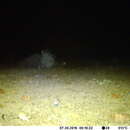en
names in breadcrumbs


Antechinomys laniger has many common names, including kultarr, Jerboa-marsupial, Jerboa marsupial mouse, wuhl-wuhl, and pitchi-pitchi.
Kultarrs utilize olfactory cues during mate selection. Parents and offspring also communicate vocally. Young use calls to locate their parents when they become separated. Kultarrs have abnormally large eyes and ears that are adapted to their nocturnal and fossorial lifestyle.
Communication Channels: acoustic ; chemical
Perception Channels: visual ; tactile ; acoustic ; chemical
Antechinomys laniger is considered a species of Least Concern by the IUCN. It is widespread, and populations are believed to fluctuate with rain levels. The US Fish & Wildlife service, however, listed this species as endangered in 1970. Over-grazing by cattle and sheep as well as predation by feral cats and red foxes are major threats, and localized extinctions have occurred. Changes in fire regime also negatively affect kultarrs. Protection of land and animal control programs have helped conserve this species. However, additional research on food habits, home range, and movement are necessary for more specific management programs.
US Federal List: endangered
CITES: no special status
There are no known adverse effects of kultarrs on humans.
There are no known direct benefits of kultarrs on humans. They may affect populations of pest insects they prey upon.
Kultarrs may affect populations of the insects they prey upon.
Kultarrs are insectivorous and feed mostly on spiders, cockroaches, and crickets. Their agility and speed allow them to catch quick and poisonous prey.
Animal Foods: insects; terrestrial non-insect arthropods
Primary Diet: carnivore (Insectivore )
Kultarrs, Antechinomys laniger, are endemic to Australia. They are found in Northern Australia, Western Australia, and New South Wales. Localized extinctions of this species have been detected in New South Wales and South Australia. There are two regional subspecies of kultarrs. Antechinomys laniger laniger is located in the eastern part of the overall species range, and A. l. spenceri in the central and western parts of this range.
Biogeographic Regions: australian (Native )
Kultarrs inhabit arid to semi-arid plains. They prefer heavy soils including stoney, sandy, or clay filled soils. During the day, they seek cover in stumps, spinifex tussocks, cracks in the soil, and burrows of other animals. Antechinomys laniger laniger prefers claypans in Acacia woodlands, while A. l. spenceri prefers plains of granite and shrub lands.
Habitat Regions: temperate ; terrestrial
Terrestrial Biomes: savanna or grassland ; forest ; scrub forest
Kultarrs are relatively long lived mammals for their size. Lifespan may be impacted by their ability to enter spontaneous torpor. The oldest known Kultarr lived 67 months in the wild, while the oldest in captivity lived 48 months.
Range lifespan
Status: wild: 67 (high) months.
Range lifespan
Status: captivity: 48 (high) months.
Kultarrs are small and mouse-like in appearance. The pelt is grey to sandy brown, and the long tail has brush-like dark hairs on the sides. The dark coloring around the eyes, mid-line, and top of the head varies among individuals. They are primarily nocturnal and, as such, have large round eyes and enlarged ears. They have elongated hind feet with four independent digits.
Kultarrs weigh 20 to 30 g and measure 170 to 200 mm in length. They exhibit sexual dimorphism with males being about 15 mm longer and 10 g heavier than females.
Range mass: 20 to 30 g.
Range length: 170 to 200 mm.
Sexual Dimorphism: male larger
Other Physical Features: endothermic ; bilateral symmetry
Primary predators of kultarrs include feral cats and red foxes. Their nocturnal lifestyle and agility help them to avoid many predators. During the day, kultarrs stay in the nest to avoid diurnal predators. Juveniles stay safe in the pouch or nest. When juveniles do leave the nest, they attach to their mother's back.
Known Predators:
Little is known about mating systems of Kultarrs. It is suspected that olfactory cues are used in mate selection.
Kultarrs are a polyoestrous mammals, and females may enter oestrus up to 6 times during the breeding season. Oestrus cycles occur from July to January and may be photo-dependent. The long breeding season runs from midwinter to midsummer. Breeding females have a supple pouch, elongated nipples, and long red-brown hairs. Males begin spermatorrheoea in May. Kultarrs have 1 to 8 offspring (average 6). Gestation lasts 12 to 17 days. After birth, the young crawl into the pouch, where they remain for 30 to 48 days. Weening occurs at 80 to 90 days of age in captivity. After the breeding season, the female's pouch regresses into a small fold. Kultarrs reach sexual maturity at 11.5 months of age.
Breeding interval: Kultarrs may breed more than once each breeding season.
Breeding season: Kultarrs breed from midwinter to midsummer.
Range number of offspring: 1 to 8.
Average number of offspring: 6.
Range gestation period: 12 to 17 days.
Range weaning age: 80 to 90 days.
Average age at sexual or reproductive maturity (female): 11.5 months.
Average age at sexual or reproductive maturity (male): 11.5 months.
Key Reproductive Features: iteroparous ; seasonal breeding ; gonochoric/gonochoristic/dioecious (sexes separate); sexual ; fertilization ; viviparous
Female kultarrs feed and protect the offspring in their pouch for 30 to 48 days. After they are weaned, young remain in the nest as the mother forages. When older, they ride on their mother's back as she searches for food.
Parental Investment: female parental care ; pre-hatching/birth (Provisioning: Female, Protecting: Female); pre-weaning/fledging (Provisioning: Female, Protecting: Female); pre-independence (Provisioning: Female, Protecting: Female)